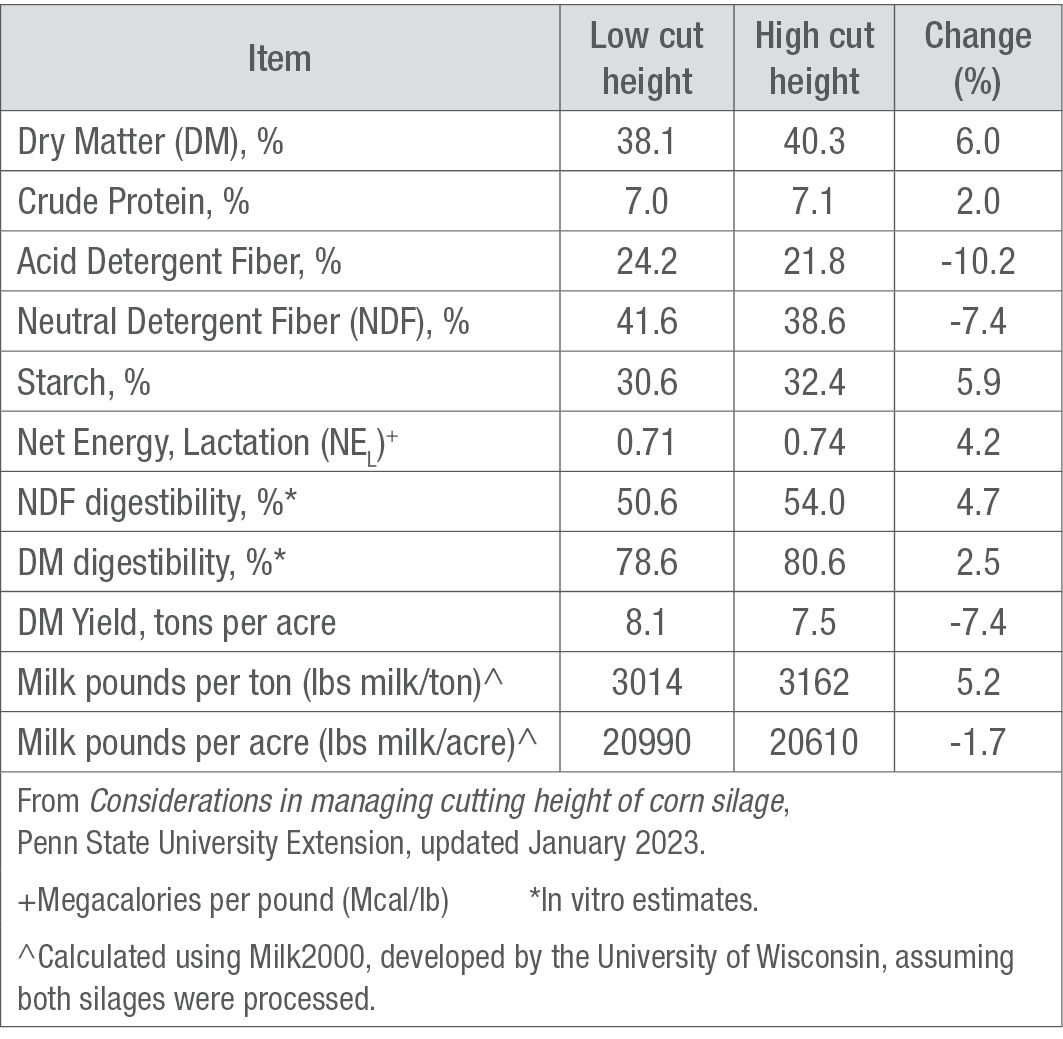Impact of Chopping Height on Yield and Quality of Corn Silage
September 25, 2023
Overview
Corn silage is a popular forage for ruminant animals because it is high in energy and digestibility.1 It typically accounts for about 30 to 40% of the diet for dairy cows.2 Maximizing profitability in corn silage production requires not only high yield, but also high quality. Proper management of silage is influenced by multiple factors including corn product selection, plant population, harvest timing, the height and length of cut, and storage. In recent years, there has been a lot of interest in raising the cutting height of corn silage during harvest to improve the forage quality. An analysis of silage should be done to determine dry matter content, as well as energy content, energy availability, and protein content to properly formulate rations.
Effects of Cutting Height on Nutritional Content, Animal Performance, and Economic Considerations of Corn Silage Production
Multiple studies conducted by university researchers have consistently found that a normal cutting height of 6 to 8 inches results in maximum yield and maximum milk per acre. Most of these studies used silage cutting heights of about 6 inches for the short-cut silage and about 18 inches for the high cut in their comparisons. By increasing cutting height 12 inches, the following results were found: 3,4,5
- Silage yield (tons per acre) was reduced by 8 to 15%.
- Silage moisture was decreased by 3 to 4%.
- Milk production per acre (Milk/ac) was reduced by 2 to 4%.
- Milk production per ton (Milk/ton) increased by nearly 5%.
Eleven trials conducted at multiple universities between 1996 and 2003 studying the nutritional and production differences of corn silage harvested at two different cutting heights was summarized by Penn State University Extension. The average low cutting height was 6.8 inches, while the average high cutting was 19.3 inches (difference of 12.5 inches). As shown in Table 12 the higher cutting height resulted in decreased:
- Dry matter (DM) yield
- Percent acid detergent fiber (ADF)
- Percent neutral detergent fiber (NDF)
- Milk/ac
Higher cutting height resulted in increased:
- Crude protein (CP)
- Starch content
- NDF digestibility
- DM digestibility
- Milk/ton
Cutting height trials conducted in 2011 and 2021 by researchers from Bayer Crop Science produced results that support the findings from the university studies.
Table 1. Nutritional changes in corn silage from two cutting heights.

Animal performance was analyzed along with the nutritional changes that were found between the two cutting heights. Feeding trials conducted at the US Dairy Forage Research Center and University of Wisconsin, and an additional trial conducted at the University of Delaware compared the effect of two cutting heights, with those silages being included in the animal’s diet at 40% of the ration. As expected, the yield from the high cutting was less than the low cut. The results of the feeding trials indicated that dry matter intake by the cows was not affected by cutting height. Milk yield was increased for the higher cut by an average of three pounds of milk per day, while milk fat content decreased from 3.5% to 3.2%. These data would indicate that the net benefit of feeding the higher-cut silage to dairy cows was minimal.2
In two other feeding trials in which rations were formulated on an equal NDF basis, researchers concluded that 3% less grain was needed in diets containing the high-cut silage due to the lower NDF content compared to the low-cut silage. Milk yield and milk fat content were not affected by the differences in the two rations. This suggests that perhaps a trade-off could exist between less grain and more forage without affecting milk production.2
Economic returns were considered using data collected in the trials previously mentioned. Using the estimated net energy for lactation (NEL) values from Table 1 of 0.74 Mcal per pound for the high-cut silage, compared to 0.71 for low cut, the amount of silage included in the ration could be increased by 6% and the amount of grain reduced by 6% while maintaining the same NEL. This resulted in a savings of $0.07 per cow per day in feed costs. However, the three pound per day gain in milk production was offset by the lower price for milk due to the lower milk fat content. Coupled with less silage yield, this resulted in a slight loss of income per acre. Ultimately, they concluded that the response to high-cut silage varies with the herd’s production and changes in milk fat content.
Growers should also consider that higher-cut silage may allow for earlier harvest since it will typically have a lower moisture content compared to lower-cut silage. The increased amount of residue that is left in the field as a result of higher cutting height can assist with soil erosion control and also capture additional snow in the winter compared to typical cutting heights.
Additionally, drought-stressed corn harvested for silage may have elevated nitrate levels in the lower portion of the stalks, which could potentially be toxic to livestock. In drought-stressed conditions, higher cutting heights can help reduce the amount of nitrate in the silage to less dangerous levels.2,3,4
More information on cutting stressed corn for silage can be found in the following articles:
BMPs for Corn Silage Production
Sources:
1Wheaton, H.N., Martz, F., Meinershagen, F., Sewell, H. 1993. Corn silage. G4590. University of Missouri Extension. https://mospace.umsystem.edu/xmlui/handle/10355/7262
2Roth, G.W. and Wu, Z. 2023. Considerations in managing cutting height of corn silage. PennState Extension. https://extension.psu.edu/considerations-in-managing-cutting-height-of-corn-silage
3Barnhart, S. 2009. Harvesting high-quality corn silage. Iowa State University Extension and Outreach, Integrated Crop Management. https://crops.extension.iastate.edu/cropnews/2009/08/harvesting-high-quality-corn-silage
4Coulter, J. 2021. Harvest strategies for corn silage. University of Minnesota Extension. https://extension.umn.edu/corn-harvest/harvest-strategies-corn-silage#determining-the-cutting-height-1196011
5Lauer, J. 1998. Corn silage yield and quality trade-offs when changing cutting height. University of Wisconsin. Agronomy Advice, Field Crops 28.47-20. http://corn.agronomy.wisc.edu/AA/A020.aspx
Web sources verified 9/8/2023.
1227_286803